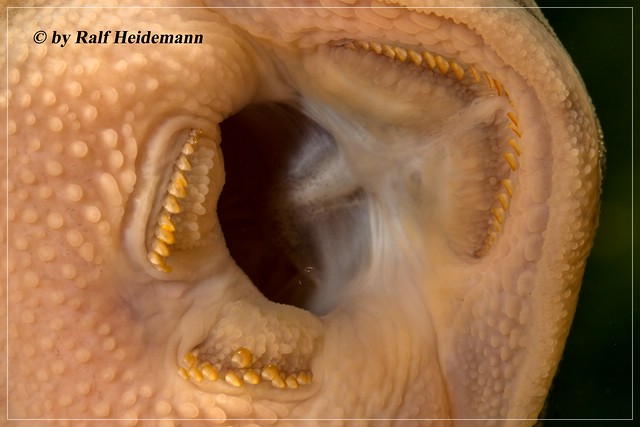|
Beschreibung:
|
Gattung/Art: Cochliodon khimaera (Tencatt et al., 2014)
Synonyme: Hypostomus khimaera (Tencatt et al., 2014)
Herkunft: Brasilien, Bundesstaat Mato Grosso, Serra das Araras, Porto Estrela, Córrego Salobo, Rio Paraguay Becken, 15°39'03"S 57°12'54"W
Größe: 16,4 cm (SL) - 25 cm (XL)
Wasserwerte:
T: 24 - 29 °C
Empfohlene Beckengröße: 120 cm

Ein Cochliodon khimaera, der bei der wissenschaftlichen Erstbeschreibung
mit eingebunden war, zur Verfügung gestellt von Otávio Fröhlich.
Sonstiges:
Cochliodon khimaera ähnelt mit seinem dunkelbraunen Streifen an der Körperseite Cochliodon basilisco und Cochliodon soniae.
Im Gegensatz zu diesen hat Cochliodon khimaera kleine schwarze Punkte auf Körper und Flossen oder mindestens an Körper oder Flossen. Die Art hat mit 12-27 im Gattungsvergleich relativ viele zweispitzige Zähne mit einer kleinen seitlichen Kuppe.
Von einigen Ichthyologen wird die Gattung Cochliodon nicht als eigenständig anerkannt, sondern als Synonym von Hypostomus angesehen und als Hypostomus cochliodon Gruppe bezeichnet.

Ein Alttier von Cochliodon khimaera.
Quellen:
"Two new species of the Hypostomus cochliodon group (Siluriformes: Loricariidae) from the rio Paraguay basin, with a redescription of Hypostomus cochliodon Kner, 1854"; Luiz F. C. Tencatt, Cláudio H. Zawadzki und Otávio Froehlich; Neotropical Ichthyology v. 12 (no. 3): 585-602, 2014.

Die Zähne eines Alttieres von Cochliodon khimaera.
Das Diskussionsforum zum Thema Welsfutter findet ihr hier.

Ein Alttier von Cochliodon khimaera.
Two new species of the Hypostomus cochliodon group (Siluriformes: Loricariidae) from the rio Paraguay basin, with a redescription of Hypostomus cochliodon Kner, 1854
Luiz F. C. Tencatt, Cláudio H. Zawadzki, Otávio Froehlich
Abstract
Hypostomus cochliodon group is a monophyletic clade of 20 valid species of Neotropical armored catfishes that is widely distributed throughout South America. Recently, specimens identified as H. cochliodon from the type locality and nearby localities were examined, and found to include representatives of more than one species. A redescription of H. cochliodon is provided, with a description of two new species, one from the Bodoquena Plateau and another from several localities of the rio Paraguay basin. A lectotype for H. cochliodon is designated herein, since the previous designation is invalid. Hypostomus cochliodon is diagnosed from all other species of the H. cochliodon group by having the opercle almost completely covered laterally by thick layer of skin, the absence of buccal papilla, weak to moderately developed keels on the lateral plates of the body and by the color pattern of its body and fins. Hypostomus basilisko, new species, is distinguished from the remaining species of the H. cochliodon group by the absence of spots on the body, highly developed keels and spoon-shaped teeth. Hypostomus khimaera, new species, is distinguished from the other species of the H. cochliodon group by having a dark tan stripe along the midline of the flank, black spots on the body and/or fins and teeth with mesial cusp and not spoon-shaped.
Link zum Paper

Ein Alttier von Cochliodon khimaera.
 Erst 2014 wurde der Hypostomus khimaera / Cochliodon khimaera wissenschaftlich beschrieben.
Erst 2014 wurde der Hypostomus khimaera / Cochliodon khimaera wissenschaftlich beschrieben.
Diese Welse sind im Rio Paraguay im brasilianischen Bundesstaat Mato Grosso beheimatet.
Dieses ist ein adultes Tier im XXL-Format. Solche stattlichen Exemplare sind in der Aquaristik selten zu finden.
Autor: Karsten S.
Wir bedanken uns für die Bilder bei Otávio Fröhlich und Ralf Heidemann.
Wer Informationen hat bezüglich Cochliodon khimaera, die noch nicht
berücksichtigt wurden, kann sie gleich als Antwort unter diesen Datenbankeintrag setzen.
Bei der nächsten Bearbeitung dieses Eintrags wird dieses dann berücksichtigt.
Wir sind immer daran interessiert, gutes Bildmaterial für die Datenbank zu sammeln. Wer
diesbezüglich eigene Aufnahmen für die Datenbank hat und diese zur Verfügung stellt,
kann dies hier tun.
  Erst 2014 wurde der Hypostomus khimaera / Cochliodon khimaera wissenschaftlich beschrieben.
Erst 2014 wurde der Hypostomus khimaera / Cochliodon khimaera wissenschaftlich beschrieben.
Diese Welse sind im Rio Paraguay im brasilianischen Bundesstaat Mato Grosso beheimatet.
Dieses ist ein adultes Tier im XXL-Format. Solche stattlichen Exemplare sind in der Aquaristik selten zu finden. |

